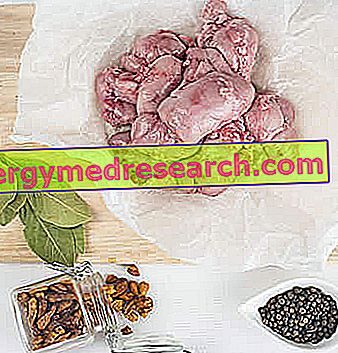What are sweetbreads?
Sweetbreads are meat ingredients that are part of the Fundamental Group of Foods; as such, they represent excellent sources of high biological value proteins, B vitamins and certain minerals.

"Animelle" is a noun that indicates one or more organs belonging to the young bovine or ovine, usually calf or lamb.
The ingredients of sweetbreads can vary according to the regional tradition.
In general, sweetbreads are composed of one or more of the following glands:
- Thyme: endocrine gland positioned under the neck. It is usually the main ingredient or the only ingredient.
- Pancreas: endocrine and exocrine gland located in the abdominal cavity.
- Salivary glands: exocrine glands located within the oral cavity.
Nutritional Features
Veal thyme, which we will later simply call sweetbreads, is an ingredient characterized by a contained energy supply.
Raw food calories come essentially from proteins, followed by lipids; carbohydrates and fibers are absent.
Peptides are of high biological value. This means that the qualitative and quantitative composition of the amino acids makes these proteins very similar to the human ones; therefore they are very nutritious.
Fatty acids are mainly unsaturated.
Cholesterol is high.
Good concentrations of phosphorus and potassium are found among the minerals contained in sweetbreads.
As far as vitamins are concerned, the amount of niacin (vitamin PP) is appreciable.
Sweetbreads do not lend themselves to all diets. In particular, they are poorly suited to the clinical nutrition of hypercholesterolemia.
Many types of offal possess good concentrations of collagen, which can compromise the digestibility of the product even after cooking. Sweetbreads "should not" be as rich as other organs (such as tripe). Nevertheless, in the case of gastric and esophageal diseases, it is not advisable to exceed the total portion (especially in the meal before going to bed).
Sweetbreads are not accepted by the vegan philosophy and vegetarian lacto-ovo.
They do not contain gluten and lactose.
The sweetbreads of sheep and cattle should be considered kosher foods, as they come from animals considered as such (ruminated cloven hoof).
They are also considered halal food, therefore, they are accepted by the Muslim religion.
On the contrary, they are not admitted by Hinduism.
Depending on the energy and lipid content, the average portion of sweetbreads could be 100 grams or slightly higher; however, for the cholesterol concentration it is advisable to further reduce it or limit its consumption to "one-off".
 | ||
| Edible part | 100.0% | |
| water | 79, 2g | |
| Protein | 17, 2g | |
| Prevailing amino acids | - | |
| Amino acid less present | - | |
| Lipids TOT | 1.8g | |
| Saturated fatty acids | 0, 81mg | |
| Monounsaturated fatty acids | 0, 78mg | |
| Polyunsaturated fatty acids | 0, 23mg | |
| Cholesterol | 250, 0mg | |
| TOT Carbohydrates | 0.0g | |
| Starch | 0.0g | |
| Soluble sugars | 0.0g | |
| Dietary fiber | 0.0g | |
| Soluble fiber | 0.0g | |
| Insoluble fiber | 0.0g | |
| Power | 85, 2kcal | |
| Sodium | 67, 0mg | |
| Potassium | 488, 0mg | |
| Iron | 1, 1mg | |
| Football | 3, 0mg | |
| Phosphorus | 533, 0mg | |
| Zinc | 1, 55mg | |
| Thiamine | 0, 07mg | |
| Riboflavin | 0, 19mg | |
| Niacin | 4, 77mg | |
| pyridoxine | 0, 04mg | |
| folate | 22, 00μg | |
| Vitamin A | 0, 00μg | |
| C vitamin | 49, 20mg | |
| Vitamin E | 0, 09mg | |
Gastronomic aspects
The calf's thyme is white in color, with a typically spongy consistency and a delicate flavor.
The gastronomic role of sweetbreads is mainly of the second course, but sometimes they are used to cook the sauces accompanying the former or as an ingredient for some unique dishes.
There are many differences between the processing and the cooking systems used in the various Italian locations but (almost everywhere) sweetbreads are cooked in the pan.
They do not require very prolonged cooking and large quantities of oil.
They lend themselves to the accompaniment of non-sparkling and medium-structured red wines.



